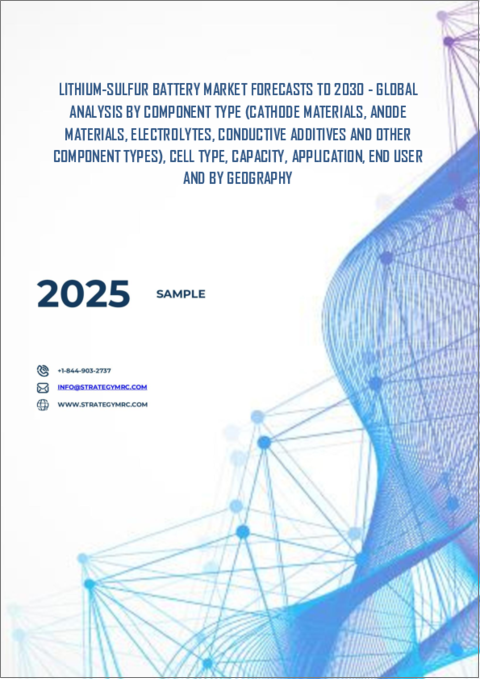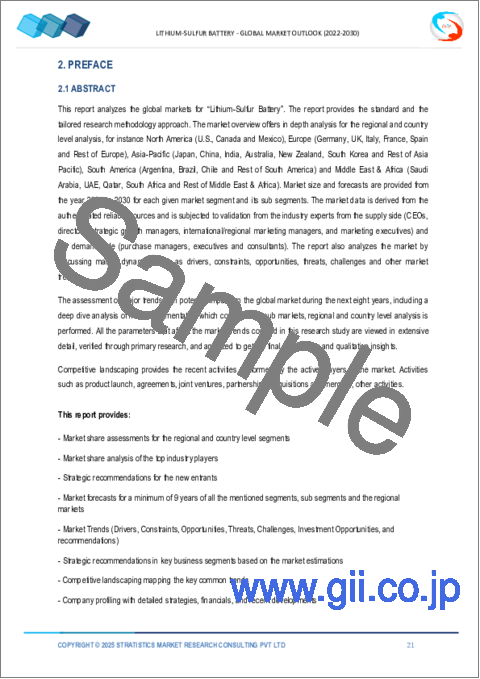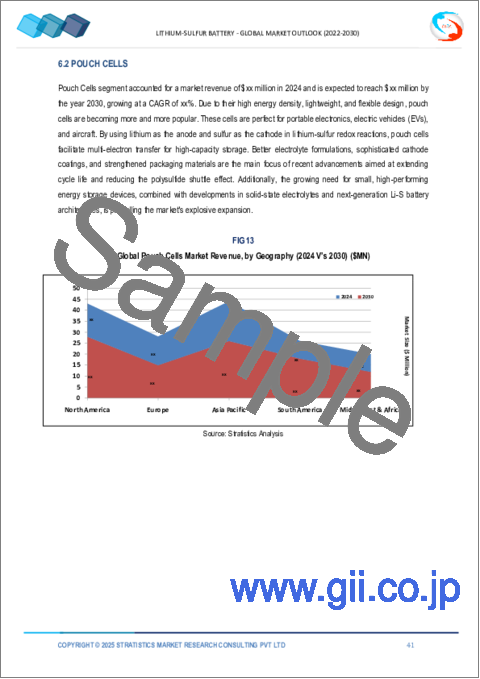|
|
市場調査レポート
商品コード
1569786
リチウム硫黄電池市場の2030年までの予測:コンポーネントタイプ、セルタイプ、容量、用途、エンドユーザー、地域別の世界分析Lithium-Sulfur Battery Market Forecasts to 2030 - Global Analysis By Component Type (Cathode Materials, Anode Materials, Electrolytes, Conductive Additives and Other Component Types), Cell Type, Capacity, Application, End User and By Geography |
||||||
カスタマイズ可能
|
|||||||
| リチウム硫黄電池市場の2030年までの予測:コンポーネントタイプ、セルタイプ、容量、用途、エンドユーザー、地域別の世界分析 |
|
出版日: 2024年10月10日
発行: Stratistics Market Research Consulting
ページ情報: 英文 200+ Pages
納期: 2~3営業日
|
全表示
- 概要
- 図表
- 目次
Stratistics MRCによると、リチウム硫黄電池の世界市場は2024年に4,470万米ドルを占め、2030年には3億4,880万米ドルに達する見込みで、予測期間中のCAGRは40.8%です。
リチウム硫黄電池は、負極にリチウム、正極に硫黄を組み合わせた先進的な二次電池で、理論エネルギー密度が約500Wh/kgと高いです。この技術は、従来のリチウムイオン二次電池に比べ、硫黄が豊富に含まれているため軽量で低コストという大きな利点があります。作動中、リチウムイオンは電極間を移動し、放電生成物として硫化リチウムを形成します。現在進行中の調査では、エネルギー貯蔵用途で電池の能力をフルに発揮させるため、こうした問題の改善に重点的に取り組んでいます。
クリーンエネルギー技術への投資の増加
クリーン・エネルギー技術への投資の増加は、市場を大きく後押ししています。その高いエネルギー密度とコスト削減の可能性を認識し、利害関係者は研究開発に資金を投入しています。この資金援助は、サイクル寿命の制限やポリサルファイドの溶解といった課題に対処することを目的としています。業界のリーダーと研究機関のコラボレーションは、技術革新を促進し、性能を向上させ、スケーラビリティを改善しています。
複雑な製造プロセス
市場における複雑な製造工程は、製造コストの増加やリードタイムの長期化につながる可能性があり、投資の妨げや市場導入の遅れにつながる可能性があります。このような複雑な工程は、しばしば特殊な設備と熟練した労働力を必要とするため、拡張性が制限され、ボトルネックとなります。さらに、品質管理の維持に課題があると、不良率が高くなり、全体的な信頼性と性能に影響を及ぼす可能性があります。その結果、生産の複雑さが潜在的な成長の妨げになる可能性があります。
再生可能エネルギー需要の拡大
再生可能エネルギーへの需要の高まりは、効率的なエネルギー貯蔵の必要性によって市場を大きく押し上げます。太陽エネルギーや風力エネルギー源が拡大する中、断続的な電力を貯蔵し、安定したエネルギー供給を確保するためには、信頼性の高い電池が不可欠です。エネルギー密度が高く、低コストが期待できるリチウム硫黄電池は、この用途で実行可能な選択肢と見なされるようになってきています。このような需要の高まりは、電池技術の革新を支えるだけでなく、世界の持続可能性の目標にも合致しており、市場の成長を加速させています。
高い初期コスト
これらの電池を製造するのに必要な高度な材料と複雑な製造工程は、より確立された技術に比べて魅力的でない高額な費用の一因となっています。この金銭的ハードルは潜在的投資家を躊躇させ、特に価格に敏感な分野での市場浸透を制限する可能性があります。さらに、多額の先行投資が必要なため、研究開発努力が鈍り、最終的には技術革新とリチウム硫黄電池技術の長期的成長の可能性が妨げられる可能性があります。
COVID-19の影響:
COVID-19の大流行は、サプライチェーンを混乱させ、生産と納品に遅れを生じさせることで市場に影響を与えました。操業停止や制限によって製造能力が妨げられ、重要な材料や部品の不足につながった。さらに、パンデミック期間中の投資の減少や研究イニシアチブの停滞は、技術の進歩を妨げました。産業が遠隔操作に適応するにつれて、信頼性の高いエネルギー貯蔵ソリューションに対する需要はより顕著になったが、市場はパンデミック後の再生可能エネルギーソリューションに対する需要の高まりに対応するための生産規模の拡大という課題に直面しました。
パウチセル分野は予測期間中最大になると予測される
パウチセル分野は、予測期間中に最大の市場シェアを占めると予測されています。その柔軟な設計は効率的なパッケージングを可能にし、電気自動車や携帯機器などスペースに制約のある用途に適しています。パウチセルは、充放電サイクル中のリチウム硫黄材料の体積変化にうまく対応できるため、性能と寿命が向上する可能性があります。高性能でコンパクトなエネルギー貯蔵ソリューションへの需要が高まるにつれ、パウチセルは、この進化する市場において、その革新的な能力からますます支持されるようになっています。
医療機器分野は予測期間中に最も高いCAGRが見込まれる
医療機器分野は、予測期間中に最も高いCAGRが見込まれます。これらの電池は、ポータブル診断機器や移植可能な機器に電力を供給することができ、充電間の動作寿命が長くなります。低コストと安全性の向上が期待できるため、従来のバッテリー技術に代わる魅力的な選択肢となります。ヘルスケアにおける信頼性が高く効率的なエネルギー源の需要が高まり続ける中、リチウム硫黄電池は医療技術の性能と利便性を高める態勢を整えています。
最大のシェアを占める地域
予測期間中、北米地域が最大のシェアを占めると予想されます。電気自動車と再生可能エネルギー貯蔵に焦点を当て、企業はリチウム硫黄電池の性能と価格を高めるための研究開発に投資しています。さらに、二酸化炭素排出量の削減を目的とした政府の支援政策が、この分野の技術革新を促進しています。市場が発展するにつれ、この地域は市場の展望において重要な役割を果たすようになると思われます。
CAGRが最も高い地域:
アジア太平洋地域は、再生可能エネルギーと電気自動車の導入に力を入れており、予測期間中に最も高い成長率を記録すると予想されます。中国、日本、韓国などの国々は、エネルギー密度の向上とコスト削減を求めて、バッテリー技術を強化するための研究開発に多額の投資を行っています。さらに、ポータブル電子機器とグリッド・ストレージ・ソリューションの需要が高まっていることも、この地域が世界市場をリードする原動力となっています。
無料カスタマイズサービス:
本レポートをご購読のお客様には、以下の無料カスタマイズオプションのいずれかをご利用いただけます:
- 企業プロファイル
- 追加市場プレイヤーの包括的プロファイリング(3社まで)
- 主要企業のSWOT分析(3社まで)
- 地域セグメンテーション
- 顧客の関心に応じた主要国の市場推計・予測・CAGR(注:フィージビリティチェックによる)
- 競合ベンチマーキング
- 製品ポートフォリオ、地理的プレゼンス、戦略的提携に基づく主要企業のベンチマーキング
目次
第1章 エグゼクティブサマリー
第2章 序文
- 概要
- ステークホルダー
- 調査範囲
- 調査手法
- データマイニング
- データ分析
- データ検証
- 調査アプローチ
- 調査情報源
- 1次調査情報源
- 2次調査情報源
- 前提条件
第3章 市場動向分析
- 促進要因
- 抑制要因
- 機会
- 脅威
- 用途分析
- エンドユーザー分析
- 新興市場
- COVID-19の影響
第4章 ポーターのファイブフォース分析
- 供給企業の交渉力
- 買い手の交渉力
- 代替品の脅威
- 新規参入業者の脅威
- 競争企業間の敵対関係
第5章 世界のリチウム硫黄電池市場:コンポーネントタイプ別
- カソード材料
- アノード材料
- 電解質
- 導電性添加剤
- その他のコンポーネントタイプ
第6章 世界のリチウム硫黄電池市場:セルタイプ別
- パウチセル
- 円筒形セル
- プリズマティックセル
第7章 世界のリチウム硫黄電池市場:容量別
- 0~500mAh
- 500~1000mAh
- 1000mAh以上
第8章 世界のリチウム硫黄電池市場:用途別
- 電気自動車(EV)
- 航空宇宙
- グリッドストレージ
- 家電
- 医療機器
- その他のアプリケーション
第9章 世界のリチウム硫黄電池市場:エンドユーザー別
- 自動車
- 航空宇宙
- エレクトロニクス
- 電力部門
- ヘルスケア
- その他のエンドユーザー
第10章 世界のリチウム硫黄電池市場:地域別
- 北米
- 米国
- カナダ
- メキシコ
- 欧州
- ドイツ
- 英国
- イタリア
- フランス
- スペイン
- その他欧州
- アジア太平洋
- 日本
- 中国
- インド
- オーストラリア
- ニュージーランド
- 韓国
- その他アジア太平洋地域
- 南米
- アルゼンチン
- ブラジル
- チリ
- その他南米
- 中東・アフリカ
- サウジアラビア
- アラブ首長国連邦
- カタール
- 南アフリカ
- その他中東とアフリカ
第11章 主な発展
- 契約、パートナーシップ、コラボレーション、合弁事業
- 買収と合併
- 新製品発売
- 事業拡大
- その他の主要戦略
第12章 企業プロファイリング
- BASF
- 24M Technologies
- Panasonic
- Samsung SDI
- LG Chem
- Toshiba
- Alveo Technologies
- Nexeon
- Nanotech Energy
- Gelion Technologies Pty Ltd.
- Merck KGaA
- Graphene Batteries AS
- Johnson Matthey
- Theion GmbH
- Zeta Energy LLC
List of Tables
- Table 1 Global Lithium-Sulfur Battery Market Outlook, By Region (2022-2030) ($MN)
- Table 2 Global Lithium-Sulfur Battery Market Outlook, By Component Type (2022-2030) ($MN)
- Table 3 Global Lithium-Sulfur Battery Market Outlook, By Cathode Materials (2022-2030) ($MN)
- Table 4 Global Lithium-Sulfur Battery Market Outlook, By Anode Materials (2022-2030) ($MN)
- Table 5 Global Lithium-Sulfur Battery Market Outlook, By Electrolytes (2022-2030) ($MN)
- Table 6 Global Lithium-Sulfur Battery Market Outlook, By Conductive Additives (2022-2030) ($MN)
- Table 7 Global Lithium-Sulfur Battery Market Outlook, By Other Component Types (2022-2030) ($MN)
- Table 8 Global Lithium-Sulfur Battery Market Outlook, By Cell Type (2022-2030) ($MN)
- Table 9 Global Lithium-Sulfur Battery Market Outlook, By Pouch Cells (2022-2030) ($MN)
- Table 10 Global Lithium-Sulfur Battery Market Outlook, By Cylindrical Cells (2022-2030) ($MN)
- Table 11 Global Lithium-Sulfur Battery Market Outlook, By Prismatic Cells (2022-2030) ($MN)
- Table 12 Global Lithium-Sulfur Battery Market Outlook, By Capacity (2022-2030) ($MN)
- Table 13 Global Lithium-Sulfur Battery Market Outlook, By 0-500 mAh (2022-2030) ($MN)
- Table 14 Global Lithium-Sulfur Battery Market Outlook, By 500-1000 mAh (2022-2030) ($MN)
- Table 15 Global Lithium-Sulfur Battery Market Outlook, By Above 1000 mAh (2022-2030) ($MN)
- Table 16 Global Lithium-Sulfur Battery Market Outlook, By Application (2022-2030) ($MN)
- Table 17 Global Lithium-Sulfur Battery Market Outlook, By Electric Vehicles (EVs) (2022-2030) ($MN)
- Table 18 Global Lithium-Sulfur Battery Market Outlook, By Aerospace (2022-2030) ($MN)
- Table 19 Global Lithium-Sulfur Battery Market Outlook, By Grid Storage (2022-2030) ($MN)
- Table 20 Global Lithium-Sulfur Battery Market Outlook, By Consumer Electronics (2022-2030) ($MN)
- Table 21 Global Lithium-Sulfur Battery Market Outlook, By Medical Devices (2022-2030) ($MN)
- Table 22 Global Lithium-Sulfur Battery Market Outlook, By Other Applications (2022-2030) ($MN)
- Table 23 Global Lithium-Sulfur Battery Market Outlook, By End User (2022-2030) ($MN)
- Table 24 Global Lithium-Sulfur Battery Market Outlook, By Automotive (2022-2030) ($MN)
- Table 25 Global Lithium-Sulfur Battery Market Outlook, By Aerospace (2022-2030) ($MN)
- Table 26 Global Lithium-Sulfur Battery Market Outlook, By Electronics (2022-2030) ($MN)
- Table 27 Global Lithium-Sulfur Battery Market Outlook, By Power Sector (2022-2030) ($MN)
- Table 28 Global Lithium-Sulfur Battery Market Outlook, By Healthcare (2022-2030) ($MN)
- Table 29 Global Lithium-Sulfur Battery Market Outlook, By Other End Users (2022-2030) ($MN)
Note: Tables for North America, Europe, APAC, South America, and Middle East & Africa Regions are also represented in the same manner as above.
According to Stratistics MRC, the Global Lithium-Sulfur Battery Market is accounted for $44.7 million in 2024 and is expected to reach $348.8 million by 2030 growing at a CAGR of 40.8% during the forecast period. A lithium-sulfur battery is an advanced type of rechargeable battery that combines lithium as the anode and sulfur as the cathode, offering a high theoretical energy density of around 500 Wh/kg. This technology presents significant advantages over conventional lithium-ion batteries, including lighter weight and lower cost due to the abundance of sulfur. During operation, lithium ions move between the electrodes, forming lithium sulfides as discharge products. Ongoing research focuses on improving these issues to unlock the battery's full capabilities for energy storage applications.
Market Dynamics:
Driver:
Increased investment in clean energy technologies
Increased investment in clean energy technologies has significantly propelled the market. Recognizing their high energy density and potential for cost reduction, stakeholders are channeling funds into research and development. This financial support aims to address challenges like limited cycle life and polysulfide dissolution. Collaborations between industry leaders and research institutions are fostering innovation, enhancing performance, and improving scalability.
Restraint:
Complex manufacturing processes
Complex manufacturing processes in the market can lead to increased production costs and longer lead times, which may deter investment and slow down market adoption. These intricate procedures often require specialized equipment and skilled labor, limiting scalability and creating bottlenecks. Additionally, challenges in maintaining quality control can result in higher defect rates, impacting overall reliability and performance. As a result, the intricacies of production can hinder the potential growth.
Opportunity:
Growing demand for renewable energy
The growing demand for renewable energy significantly boosts the market, driven by the need for efficient energy storage. As solar and wind energy sources expand, reliable batteries are essential to store intermittent power and ensure a stable energy supply. Lithium-sulfur batteries, with their high energy density and potential for lower costs, are increasingly viewed as viable options for this application. This rising demand not only supports innovation in battery technology but also aligns with global sustainability goals, accelerating market growth.
Threat:
High initial costs
The advanced materials and complex manufacturing processes required to produce these batteries contribute to elevated expenses, making them less attractive compared to more established technologies. This financial hurdle can deter potential investors and limit market penetration, particularly in price-sensitive sectors. Additionally, the need for substantial upfront investment may slow down research and development efforts, ultimately hindering innovation and the long-term growth potential of lithium-sulfur battery technology.
Covid-19 Impact:
The COVID-19 pandemic has impacted the market by disrupting supply chains and causing delays in production and delivery. Lockdowns and restrictions hindered manufacturing capabilities, leading to shortages of critical materials and components. Additionally, reduced investments and slowed research initiatives during the pandemic hampered technological advancements. As industries adapted to remote operations, the demand for reliable energy storage solutions became more pronounced, yet the market faced challenges in scaling up production to meet the rising post-pandemic demand for renewable energy solutions.
The pouch cells segment is projected to be the largest during the forecast period
The pouch cells segment is projected to account for the largest market share during the projection period. Their flexible design allows for efficient packaging, making them suitable for space-constrained applications in electric vehicles and portable devices. Pouch cells can better accommodate the volumetric changes of lithium-sulfur materials during charge and discharge cycles, potentially enhancing performance and longevity. As the demand for high-performance, compact energy storage solutions grows, pouch cells are increasingly favored for their innovative capabilities in this evolving market.
The medical devices segment is expected to have the highest CAGR during the forecast period
The medical devices segment is expected to have the highest CAGR during the extrapolated period. These batteries can power portable diagnostic equipment and implantable devices, offering longer operational life between charges. Their potential for lower costs and improved safety makes them an attractive alternative to traditional battery technologies. As the demand for reliable, efficient energy sources in healthcare continues to rise, lithium-sulfur batteries are poised to enhance the performance and convenience of medical technologies.
Region with largest share:
North America region is expected to hold the largest share of the market during the forecast period. With a focus on electric vehicles and renewable energy storage, companies are investing in research and development to enhance the performance and affordability of lithium-sulfur batteries. Additionally, supportive government policies aimed at reducing carbon emissions are fostering innovation in this sector. As the market evolves, the region is poised to play a crucial role in the market landscape.
Region with highest CAGR:
Asia Pacific is expected to register the highest growth rate over the forecast period fuelled by the region's strong emphasis on renewable energy and electric vehicle adoption. Countries like China, Japan, and South Korea are investing heavily in research and development to enhance battery technology, seeking to improve energy density and reduce costs. Additionally, the growing demand for portable electronics and grid storage solutions further drives the region is set to lead the global market.
Key players in the market
Some of the key players in Lithium-Sulfur Battery market include BASF, 24M Technologies, Panasonic, Samsung SDI, LG Chem, Toshiba, Alveo Technologies, Nexeon, Nanotech Energy, Gelion Technologies Pty Ltd. , Merck KGaA, Graphene Batteries AS, Johnson Matthey, Theion GmbH and Zeta Energy LLC.
Key Developments:
In July 2024, Panasonic Energy Co., Ltd., announced that it has entered into an agreement regarding joint development with Australia's national science agency, CSIRO. The agreement covers the development of new nickel laterite processing technologies for recovering nickel, an essential raw material in the manufacture of lithium-ion batteries.
In April 2024, Panasonic Energy Co. Ltd., is in talks with Indian Oil Corp. Ltd for a joint venture to manufacture cylindrical lithium-ion batteries for two- and three-wheel vehicles and energy storage systems in the Indian market. It has signed a binding term sheet and initiated discussions with Indian Oil Corp. Ltd to draw a framework for the formation of the joint venture.
Component Types Covered:
- Cathode Materials
- Anode Materials
- Electrolytes
- Conductive Additives
- Other Component Types
Cell Types Covered:
- Pouch Cells
- Cylindrical Cells
- Prismatic Cells
Capacities Covered:
- 0-500 mAh
- 500-1000 mAh
- Above 1000 mAh
Applications Covered:
- Electric Vehicles (EVs)
- Aerospace
- Grid Storage
- Consumer Electronics
- Medical Devices
- Other Applications
End Users Covered:
- Automotive
- Aerospace
- Electronics
- Power Sector
- Healthcare
- Other End Users
Regions Covered:
- North America
- US
- Canada
- Mexico
- Europe
- Germany
- UK
- Italy
- France
- Spain
- Rest of Europe
- Asia Pacific
- Japan
- China
- India
- Australia
- New Zealand
- South Korea
- Rest of Asia Pacific
- South America
- Argentina
- Brazil
- Chile
- Rest of South America
- Middle East & Africa
- Saudi Arabia
- UAE
- Qatar
- South Africa
- Rest of Middle East & Africa
What our report offers:
- Market share assessments for the regional and country-level segments
- Strategic recommendations for the new entrants
- Covers Market data for the years 2022, 2023, 2024, 2026, and 2030
- Market Trends (Drivers, Constraints, Opportunities, Threats, Challenges, Investment Opportunities, and recommendations)
- Strategic recommendations in key business segments based on the market estimations
- Competitive landscaping mapping the key common trends
- Company profiling with detailed strategies, financials, and recent developments
- Supply chain trends mapping the latest technological advancements
Free Customization Offerings:
All the customers of this report will be entitled to receive one of the following free customization options:
- Company Profiling
- Comprehensive profiling of additional market players (up to 3)
- SWOT Analysis of key players (up to 3)
- Regional Segmentation
- Market estimations, Forecasts and CAGR of any prominent country as per the client's interest (Note: Depends on feasibility check)
- Competitive Benchmarking
- Benchmarking of key players based on product portfolio, geographical presence, and strategic alliances
Table of Contents
1 Executive Summary
2 Preface
- 2.1 Abstract
- 2.2 Stake Holders
- 2.3 Research Scope
- 2.4 Research Methodology
- 2.4.1 Data Mining
- 2.4.2 Data Analysis
- 2.4.3 Data Validation
- 2.4.4 Research Approach
- 2.5 Research Sources
- 2.5.1 Primary Research Sources
- 2.5.2 Secondary Research Sources
- 2.5.3 Assumptions
3 Market Trend Analysis
- 3.1 Introduction
- 3.2 Drivers
- 3.3 Restraints
- 3.4 Opportunities
- 3.5 Threats
- 3.6 Application Analysis
- 3.7 End User Analysis
- 3.8 Emerging Markets
- 3.9 Impact of Covid-19
4 Porters Five Force Analysis
- 4.1 Bargaining power of suppliers
- 4.2 Bargaining power of buyers
- 4.3 Threat of substitutes
- 4.4 Threat of new entrants
- 4.5 Competitive rivalry
5 Global Lithium-Sulfur Battery Market, By Component Type
- 5.1 Introduction
- 5.2 Cathode Materials
- 5.3 Anode Materials
- 5.4 Electrolytes
- 5.5 Conductive Additives
- 5.6 Other Component Types
6 Global Lithium-Sulfur Battery Market, By Cell Type
- 6.1 Introduction
- 6.2 Pouch Cells
- 6.3 Cylindrical Cells
- 6.4 Prismatic Cells
7 Global Lithium-Sulfur Battery Market, By Capacity
- 7.1 Introduction
- 7.2 0-500 mAh
- 7.3 500-1000 mAh
- 7.4 Above 1000 mAh
8 Global Lithium-Sulfur Battery Market, By Application
- 8.1 Introduction
- 8.2 Electric Vehicles (EVs)
- 8.3 Aerospace
- 8.4 Grid Storage
- 8.5 Consumer Electronics
- 8.6 Medical Devices
- 8.7 Other Applications
9 Global Lithium-Sulfur Battery Market, By End User
- 9.1 Introduction
- 9.2 Automotive
- 9.3 Aerospace
- 9.4 Electronics
- 9.5 Power Sector
- 9.6 Healthcare
- 9.7 Other End Users
10 Global Lithium-Sulfur Battery Market, By Geography
- 10.1 Introduction
- 10.2 North America
- 10.2.1 US
- 10.2.2 Canada
- 10.2.3 Mexico
- 10.3 Europe
- 10.3.1 Germany
- 10.3.2 UK
- 10.3.3 Italy
- 10.3.4 France
- 10.3.5 Spain
- 10.3.6 Rest of Europe
- 10.4 Asia Pacific
- 10.4.1 Japan
- 10.4.2 China
- 10.4.3 India
- 10.4.4 Australia
- 10.4.5 New Zealand
- 10.4.6 South Korea
- 10.4.7 Rest of Asia Pacific
- 10.5 South America
- 10.5.1 Argentina
- 10.5.2 Brazil
- 10.5.3 Chile
- 10.5.4 Rest of South America
- 10.6 Middle East & Africa
- 10.6.1 Saudi Arabia
- 10.6.2 UAE
- 10.6.3 Qatar
- 10.6.4 South Africa
- 10.6.5 Rest of Middle East & Africa
11 Key Developments
- 11.1 Agreements, Partnerships, Collaborations and Joint Ventures
- 11.2 Acquisitions & Mergers
- 11.3 New Product Launch
- 11.4 Expansions
- 11.5 Other Key Strategies
12 Company Profiling
- 12.1 BASF
- 12.2 24M Technologies
- 12.3 Panasonic
- 12.4 Samsung SDI
- 12.5 LG Chem
- 12.6 Toshiba
- 12.7 Alveo Technologies
- 12.8 Nexeon
- 12.9 Nanotech Energy
- 12.10 Gelion Technologies Pty Ltd.
- 12.11 Merck KGaA
- 12.12 Graphene Batteries AS
- 12.13 Johnson Matthey
- 12.14 Theion GmbH
- 12.15 Zeta Energy LLC






